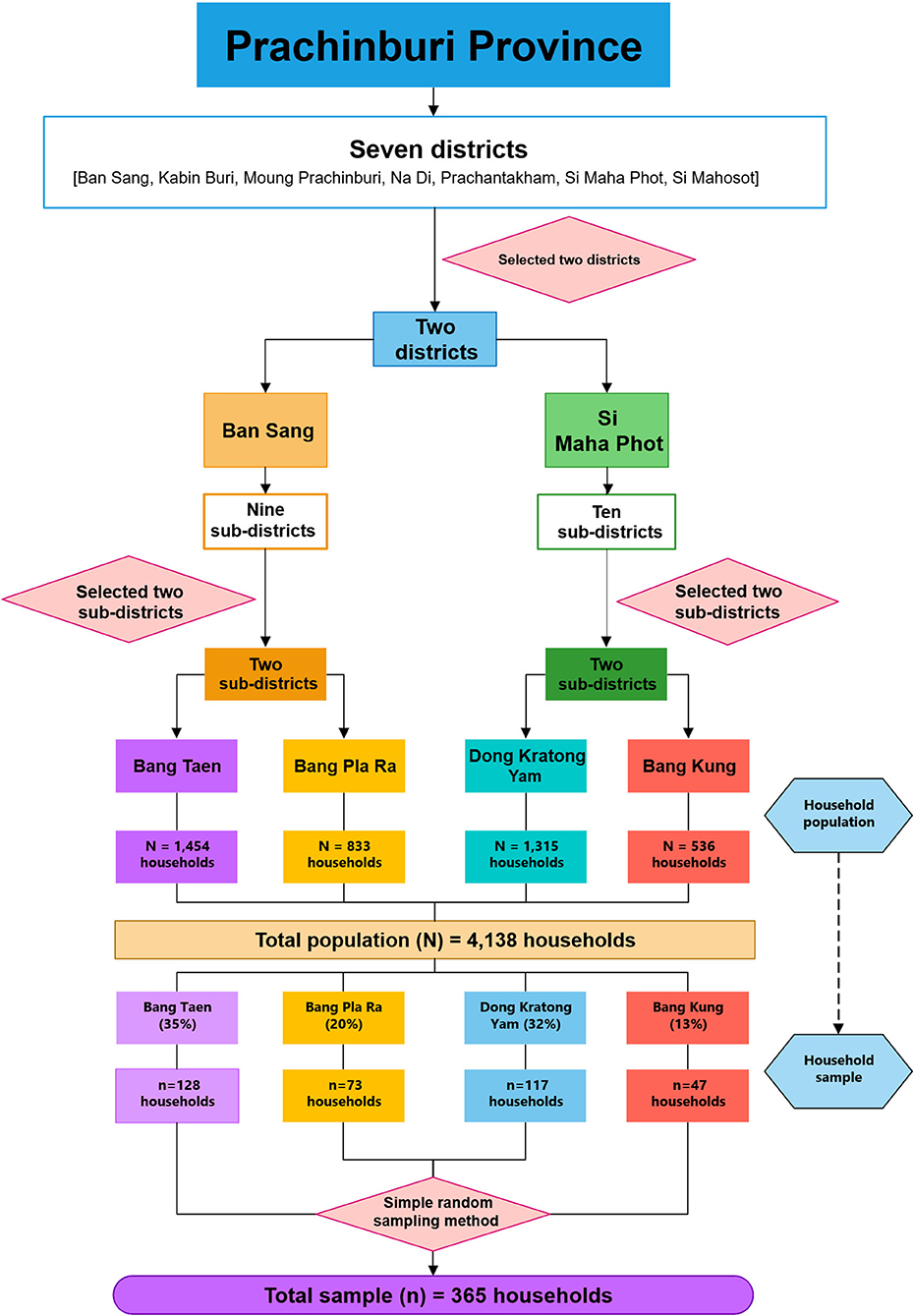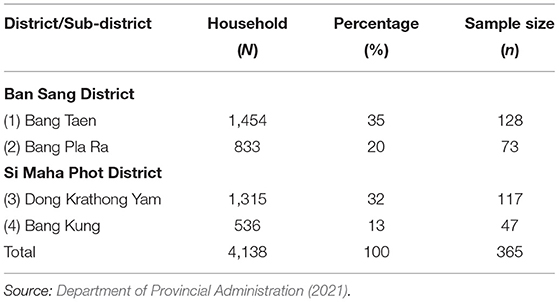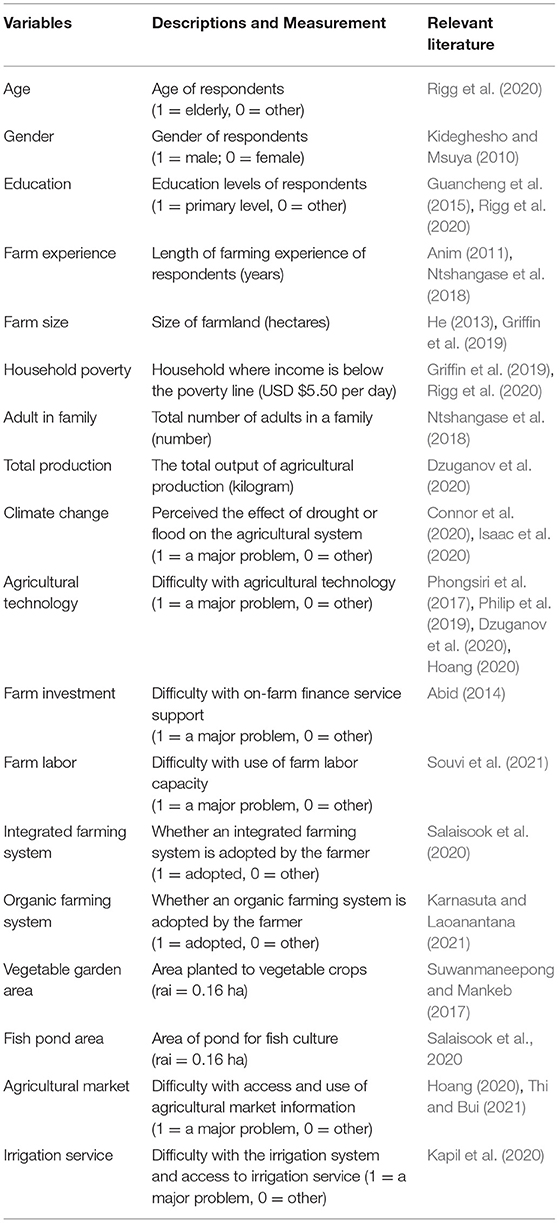- 1Department of Social Welfare and Counselling, Dongguk University, Seoul, South Korea
- 2Department of Development and Sustainability, School of Environment, Resources and Development, Asian Institute of Technology (AIT), Pathum Thani, Thailand
- 3Tata Jamsetji School of Disaster Studies, Tata Institute of Social Sciences, Mumbai, India
- 4Organization for Advanced and Integrated Research, Kobe University, Kobe, Japan
- 5College of Sciences and Engineering, University of Tasmania, Hobart, TAS, Australia
Introduction
Agriculture and food systems are critical for maintaining food and nutrition security, driving economic development, alleviating poverty, and preserving ecological functions and services on national and international agendas (Whitfield et al., 2018). Furthermore, the system intersects all the United Nations' (UN) agenda items for sustainable development goals (SDGs), highlighting a growing global concern for, and sometimes contentious debate, over food system sustainability (FAO, 2019). In the twenty-first century, agricultural and food systems have faced a complex set of local and global challenges (Whitfield et al., 2018). This includes poor diets, poverty, and environmental concerns related to water, land scarcity, and climate change as some of the major global problems (Diama et al., 2020). In order to address these issues, we need to incorporate dietary and on-farm diversity with a holistic solution and smart food approach (Diama et al., 2020).
It is generally accepted that agriculture and food systems must adapt to uncertain and changing climatic conditions by building resilience and food system sustainability (Whitfield et al., 2018; Diama et al., 2020). This requires an understanding of the dynamics and interactions of the system and how changes in agricultural practices have been shaped through learning and social interactions (Whitfield, 2015); the innovative ways that human beings adapt within changing environments (Reij and Waters-Bayer, 2001); and the multifaceted priorities and value systems of individual consumers and producers (Lusk and Briggeman, 2019). Population structure plays a significant role in understanding the key factors affecting agricultural production, including its volume and future direction (Guancheng et al., 2015). Population structure and population change can also help to identify choices regarding agricultural inputs and crop selection. Accordingly, the movement of labor from rural to urban areas during the urbanization process brings changes in agricultural form, type and pattern in rural areas (Knodel and Chayovan, 2009).
In Thailand, a high rate of rural to urban migration and declining family size plays a significant role in influencing the involvement of aging populations in agricultural production. For example, aging people are considered likely to encourage greater use of machinery to address labor shortage issues. This is a direct result of an increasingly aging population and mobility of the rural population in Thailand, which has reduced agricultural labor supplies and led to a rise in labor costs. Recent research by Rigg et al. (2020) has shown that young people who remain in rural areas gradually increase their earnings by undertaking non-farming work. Phongsiri et al. (2017) also indicate that young people are not interested in agriculture due to negative perceptions of low social status. This triggers significant involvement of the aging population in farming practices at every stage of production (e.g., pre-planting, growth-related, and post-growth), which can also reduce farming productivity (Seok et al., 2018).
Previous studies in Thailand have shown that aging farmers are often dependent on hired labor, which increases production costs (Formoso, 2016). In contrast, the aging rural population encourages restructuring of internal driving factors for agricultural production, including the use of technology, controlling farm accidents and minimizing health risks. Perceptions of these factors, albeit important, remain unexamined. The changes in labor input in the process of land-use transitions affect agricultural production in terms of labor quantity and quality. Therefore, the dominant influence is mainly through the supply of agricultural labor, agricultural land use, and the agricultural output structure. The effects of an aging population engagement are presented through large-scale production and socio-economic functions. Figure 1 shows the conceptual framework of the present study, illustrating the inter-linkages between different elements which affect the resiliency of agricultural systems.

Figure 1. Conceptual framework showing inter-linkages between different elements affecting the resiliency of agricultural systems.
Materials and Methods
Sample Selection
This study collected household data from four sub-districts in Prachinburi Province, Thailand (Table 1). First, we applied a multi-stage sampling strategy by separating total households into several groups of farm households, such as agriculture and aquaculture (Figure 2). In the first step, we adopted purposive sampling to maintain the homogeneous representation of every farming group, which included agricultural production (i.e., rain-fed and irrigated rice production) and pond aquaculture (fish and shrimp). We then applied the random sampling method to select farm households from every village with cooperating local fieldworkers at the Rice Center and the Bureau of Registration Administration (BORA) of the Department of Provincial Administration (DOPA).

Figure 2. Schematic diagram showing multi-stage sampling procedure for dividing the total households into different farming household groups.
To calculate the minimum suggested sample size, Yamane's method (Yamane, 1973) was used (see Equation 1). By doing this, we obtained a sample size of 365 households from the total population of 4,138 households in the province.
Where n indicates the minimum sample size, N refers to the total population, and e indicates the acceptable margin of error (0.05 or 5%).
The distribution of sampled households across Prachinburi province was determined using the following method (Equation 2).
Where Ka refers to the number of households selected from four sub-districts, N indicates the population of the sub-districts, and Tp indicates the total population of the province.
Development of the Questionnaire
A structured draft questionnaire was developed to guide the interviewing process and then shared with local stakeholders and collaborators involved in the project. The questionnaire was divided into four parts: (1) household demographic characteristics; (2) the current situation of agricultural sustainability, production and productivity; (3) the livelihoods and well-being of aging farmers; and (4) strategies to improve agricultural productivity and sustainability. A pilot survey was carried out with a sample of 30 households within the study area. Following rigorous field-testing, the questionnaire was finalized for implementation.
Survey Administration and Analysis
The survey was administered to households in four sub-districts within the Prachinburi region from August to October 2018. The survey procedure was conducted in three steps: (1) the survey questionnaire was translated into Thai; (2) the questionnaire was distributed to 128 respondents in Bang Taen, 73 in Bang Pla Ra, 116 in Don Kratong Yam, and 47 in Bang Kung; and (3) the cover letter explained the aim and importance of the survey, the potential participation benefits, and the criteria for respondent selection. In addition, the cover letter assured all participants of complete confidentiality. Including research assistants, a total of 365 selected respondents were interviewed.
Key Variables
The explanatory variables were selected based on the existing literature. For example, several studies conducted in different geographical contexts examined the relationship between farmers' age and productivity (Poungchompu et al., 2012; Guancheng et al., 2015). These studies used variables measuring types of agricultural production, geophysical, social and climate-related barriers to greater agricultural productivity, mentoring, use of technology, retirement, health concerns, and risks of farm accidents of the aging workforce. Farm and farmers' characteristics (i.e., age, gender and education, household income, household size, farming experience) are typically used in analyses examining agricultural sustainability (Zou et al., 2018; Filloux et al., 2019). Selected variables and data coding are presented in Table 2. All variables and related coding are available in the dataset file (Supplementary Material).
Potential Research Pathways
The dataset provides insights into the agricultural practices, sustainability, nutritional diversity, environmental and health benefits, barriers and opportunities in the Thai agricultural sector, with a focus on central Thailand. As Thailand is rapidly urbanizing and its population is experiencing rapid aging, examining ways of enhancing agricultural practices, diversifying production, and consumption behind traditional rice mono-cropping is of critical importance. Accordingly, engagement in the agricultural sector is becoming essential for policy advocacy.
Using the present dataset, researchers are presented with an opportunity to analyse the factors influencing sustainable agriculture, specifically agricultural productivity, aging farming workforce, and community well-being. Further analyses of this dataset can be undertaken by combining these data with other existing datasets. This also includes administrative data from Thailand's sub-district (tambon) offices as well as spatial data. The data can be used for comparative studies and constituting a baseline for further studies in this region. Linking with nutritional and health data can contribute to an understanding of the food security status of the aging agriculture workforce. This is also useful for mapping the health, nutrition, and its association with agricultural production throughout the region. The recent agriculture policy (Thailand 4.0) focuses on increasing yield per rai by reducing inefficiencies. The dataset will also help to understand the factors, roles, and potential issues of the aging workforce. It will help to initiate potential policies for agricultural sustainability through the involvement of an aging workforce.
Data Availability Statement
The original contributions presented in the study are included in the article/Supplementary Material, further inquiries can be directed to the corresponding authors.
Ethics Statement
Ethical review and approval was not required for the study on human participants in accordance with the local legislation and institutional requirements. Written informed consent for participation was not required for this study in accordance with the national legislation and the institutional requirements.
Author Contributions
SS and CA designed the study. CA collected the data. MP, CA, SS, TT, and KL drafted the article. All authors revised the article critically and approved the final version and agree to be accountable for all aspects of the work. All persons designated as authors qualify for authorship.
Funding
All authors acknowledge the financial support from the Deltas' Dealings with Uncertainty (DoUbT) research project funded by the French Agricultural Research Centre for International Development (CIRAD). Likewise, the authors acknowledge the funding from the UK Research and Innovation's Global Challenges Research Fund (UKRI GCRF) through the Trade, Development and the Environment Hub project (Project No. ES/S008160/1), led by the UN Environment Programme World Conservation Monitoring Centre (UNEP-WCMC).
Conflict of Interest
The authors declare that the research was conducted in the absence of any commercial or financial relationships that could be construed as a potential conflict of interest.
Publisher's Note
All claims expressed in this article are solely those of the authors and do not necessarily represent those of their affiliated organizations, or those of the publisher, the editors and the reviewers. Any product that may be evaluated in this article, or claim that may be made by its manufacturer, is not guaranteed or endorsed by the publisher.
Supplementary Material
The Supplementary Material for this article can be found online at: https://www.frontiersin.org/articles/10.3389/fsufs.2021.728120/full#supplementary-material
References
Abid, M. (2014). Farmers' perceptions of and adaptation strategies to climate change and their determinants; the case of Punjab province. Pakistan. Earth Syst. Dyn. 5, 1359–1406. doi: 10.5194/esdd-5-1359-2014
Anim, F. D. K. (2011). Factors affecting rural household farm labour supply in farming communities of South Africa. J. Hum. Ecol. 34, 23–28. doi: 10.1080/09709274.2011.11906365
Connor, M., Guia, A. H., De Quilloy, R., Nguyen, H., Van Gummert, M., and Sander, B. O. (2020). When climate change is not psychologically distant - Factors in fl uencing the acceptance of sustainable farming practices in the Mekong River Delta of Vietnam. World Dev. Perspect. 18:100204. doi: 10.1016/j.wdp.2020.100204
Department of Provincial Administration (2021). Phra Nakhon, Bangkok, Thailand. Available online at: http://stat.bora.dopa.go.th/stat/statnew/statTDD/views/showProvinceData.php (accessed April 22, 2021).
Diama, A., Anitha, S., Kane-Potaka, J., Htut, T. T., Jalagam, A., Kumar, P., et al. (2020). How the smart food concept can lead to the transformation of food systems and combat malnutrition: different approaches in africa, globally, and a case study from Myanmar with lessons learnt for creating behavior change in diets. World Rev Nutr Diet. 121, 149–158. doi: 10.1159/000507494
Dzuganov, B., Shekikhachev, Y. A., Sh, T., Chechenov, M., and Mishkhozhev, V. (2020). Status and prospects of technical equipment of small enterprises in agricultural production Status and prospects of technical equipment of small enterprises in agricultural production. IOP Conf. Ser. Mater. Sci. Eng. 919, 4–10. doi: 10.1088/1757-899X/919/3/032015
FAO (2019). The State of Food and Agriculture 2019. Moving Forward on Food Loss and Waste Reduction. Rome: FAO.
Filloux, T., Faysse, N., and Phiboon, K. (2019). Public policy to support young farmers in Thailand. Outlook Agric. 48, 292–299. doi: 10.1177/0030727019880187
Formoso, B. (2016). Are Thai Peasants still Farmers? The socio-economic transformation of two villages of Northeastern Thailand. Rech. En Sci. Hum. sur l'Asie du Sud-Est 28, 39–60. doi: 10.4000/moussons.3636
Griffin, B., Hartarska, V., and Denis, N. (2019). Retirement age farmers' exit and disinvestment from farming. Int. J. Econ. Financ. 11, 136–148. doi: 10.5539/ijef.v11n12p136
Guancheng, G., Wen, Q., and Jingjuan, Z. (2015). The impact of ageing agricultural labor population on farmland output: From the perspective of farmer preferences. Math. Probl. Eng. 4, 1–7. doi: 10.1155/2015/730618
He, X. (2013). Agricultural labor force aging research-based on surveys in rural Zhejiang Province. Popul. Econ. 2, 69–78.
Hoang, H. G. (2020). Determinants of the adoption of mobile phones for fruit marketing by Vietnamese farmers. World Dev. Perspect. 17:100178. doi: 10.1016/j.wdp.2020.100178
Isaac, N., Fromm, I., and Frimpong, B. N. (2020). Factors influencing the adoption of cocoa agroforestry systems in mitigating climate change in Ghana: the case of Sefwi Wiawso in Western Region. Environ. Sustain. Clim. Chang. 2, 20–23. doi: 10.3390/land10030266
Kapil, K., Adhikari, K. B., Shiva, C. D., and Marahatta, S. (2020). Factors determining farmers ' strength of access to the irrigation system in Kaski district of Nepal. Cogent. Food Agric. 6, 1–10. doi: 10.1080/23311932.2020.1843751
Karnasuta, S., and Laoanantana, P. (2021). Organic farming model of paddy rice production with environmental efficiency in Thailand. Turkish J. Comput. Math. Educ. 12, 3066–3074.
Kideghesho, J. R., and Msuya, T. S. (2010). Gender and socio-economic factors influencing domestication of indigenous medicinal plants in the West Usambara Mountains, northern Tanzania. Int. J. Biodivers. Sci. Ecosyst. Serv. Manag. 6, 3–12. doi: 10.1080/17451590.2010.480946
Knodel, J., and Chayovan, N. (2009). Older persons in Thailand: a demographic, social and economic profile. Ageing Int. 33, 3–14. doi: 10.1007/s12126-009-9025-8
Lusk, J. L., and Briggeman, B. C. (2019). Food values. Am. J. Agric. Econ. 91, 184–196. doi: 10.1111/j.1467-8276.2008.01175.x
Ntshangase, N. L., Muroyiwa, B., and Sibanda, M. (2018). Farmers ' perceptions and factors influencing the adoption of no-till conservation agriculture by small-scale farmers in Zashuke, KwaZulu-Natal Province. Sustainability 10:555. doi: 10.3390/su10020555
Philip, B., Daigneault, A., and Dawson, J. (2019). Age, values, farming objectives, past management decisions, and future intentions in New Zealand agriculture. J. Environ. Manage. 231, 110–120. doi: 10.1016/j.jenvman.2018.10.018
Phongsiri, M., Rigg, J., Salamanca, A., and Sripun, M. (2017). Who Will Trend the Farm and Grow the Rice? Bangkok Post. News. Available online at: https://www.bangkokpost.com/opinion/opinion/1384410/who-will-tend-the-farm-and-grow-the-rice-
Poungchompu, S., Tsuneo, K., and Poungchompu, P. (2012). Aspects of the aging farming population and food security in agriculture for Thailand and Japan. Int. J. Environ. Rural Dev. 3, 102–107.
Reij, C., and Waters-Bayer, A. (Eds.). (2001). Farmer Innovation in Africa: A Source of Inspiration for Agricultural Development. London: Earthscan.
Rigg, J., Phongsiri, M., Promphakping, B., Salamanca, A., and Sripun, M. (2020). Who will tend the farm? Interrogating the ageing Asian farmer. J. Peasant Stud. 47, 306–325. doi: 10.1080/03066150.2019.1572605
Salaisook, P., Faysse, N., and Tsusaka, T. W. (2020). Reasons for adoption of sustainable land management practices in a changing context: a mixed approach in Thailand. Land Use Policy 96:104676. doi: 10.1016/j.landusepol.2020.104676
Seok, J. H., Moon, H., Kim, G. S., and Reed, M. R. (2018). Is aging the important factor for sustainable agricultural development in Korea? Evidence from the relationship between aging and farm technical efficiency. Sustain. 10:2137. doi: 10.3390/su10072137
Souvi, K. N., Sun, C., Egbendewe-mondzozo, A., Kafui, K., and Alabi-doku, B. N. (2021). Analysis of the impacts of socio-economic factors on hiring an external labor force in tilapia farming in Southern Togo. Aquac. Fish. 6, 216–222. doi: 10.1016/j.aaf.2020.07.010
Suwanmaneepong, S., and Mankeb, P. (2017). Economic aspects of urban vegetable gardening in Bangkok Metropolitan, Thailand. Int. J. Agric. Technol. 13, 2161–2173. doi: 10.1016/j.ecolecon.2006.04.006
Thi, H., and Bui, M. (2021). Factors influencing farmers ' decision to convert to organic tea cultivation in the mountainous areas of northern. J. Org. Agric. 11, 51–61. doi: 10.1007/s13165-020-00322-2
Whitfield, S. (2015). Adapting to Climate Uncertainty in African Agriculture: Narratives and Knowledge Politics. London: Routledge. doi: 10.4324/9781315725680
Whitfield, S., Challinor, A. J., and Rees, R. M. (2018). Frontiers in climate-smart food systems: outlining the research space. Front. Sustain. Food Syst. 2:2. doi: 10.3389/fsufs.2018.00002
Yamane, T. (1973). Statistics: An Introductory Analysis. 3rd Edn. New York, NY: Harper and Row Publisher.
Keywords: aging, agricultural development, agricultural productivity, agricultural sustainability, farmers' perception, farming workforce, nutritional diversification, Thailand
Citation: Szabo S, Apipoonyanon C, Pramanik M, Tsusaka TW and Leeson K (2021) Agricultural Productivity, Aging Farming Workforce, Sustainable Agriculture, and Well-Being: Household Survey Data From Central Thailand. Front. Sustain. Food Syst. 5:728120. doi: 10.3389/fsufs.2021.728120
Received: 20 June 2021; Accepted: 28 September 2021;
Published: 08 November 2021.
Edited by:
Kathleen L. Hefferon, Cornell University, United StatesReviewed by:
Krishna Singh, Dr. Rajendra Prasad Central Agricultural University, IndiaLiz Carlisle, University of California, Santa Barbara, United States
Copyright © 2021 Szabo, Apipoonyanon, Pramanik, Tsusaka and Leeson. This is an open-access article distributed under the terms of the Creative Commons Attribution License (CC BY). The use, distribution or reproduction in other forums is permitted, provided the original author(s) and the copyright owner(s) are credited and that the original publication in this journal is cited, in accordance with accepted academic practice. No use, distribution or reproduction is permitted which does not comply with these terms.
*Correspondence: Takuji W. Tsusaka, dGFrdWppLnRzdXNha2FAZ21haWwuY29t
 Sylvia Szabo
Sylvia Szabo Chidchanok Apipoonyanon
Chidchanok Apipoonyanon Malay Pramanik3
Malay Pramanik3 Takuji W. Tsusaka
Takuji W. Tsusaka Kevin Leeson
Kevin Leeson
